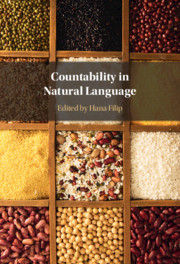Book contents
- Countability in Natural Language
- Countability in Natural Language
- Copyright page
- Contents
- Contributors
- Preface
- Introduction
- 1 Proportional Many/Much and Most
- 2 Quantity Systems and the Count/Mass Distinction
- 3 Counting Aggregates, Groups and Kinds: Countability from the Perspective of a Morphologically Complex Language
- 4 Individuating Matter over Time
- 5 Reduplication as Summation
- 6 Iceberg Semantics for Count Nouns and Mass Nouns: How Mass Counts
- 7 Indexical Inference: Counting and Measuring in Context
- 8 Counting and Measuring and Approximation
- 9 The Count/Mass Distinction for Granular Nouns
- Index
- References
9 - The Count/Mass Distinction for Granular Nouns
Published online by Cambridge University Press: 11 June 2021
- Countability in Natural Language
- Countability in Natural Language
- Copyright page
- Contents
- Contributors
- Preface
- Introduction
- 1 Proportional Many/Much and Most
- 2 Quantity Systems and the Count/Mass Distinction
- 3 Counting Aggregates, Groups and Kinds: Countability from the Perspective of a Morphologically Complex Language
- 4 Individuating Matter over Time
- 5 Reduplication as Summation
- 6 Iceberg Semantics for Count Nouns and Mass Nouns: How Mass Counts
- 7 Indexical Inference: Counting and Measuring in Context
- 8 Counting and Measuring and Approximation
- 9 The Count/Mass Distinction for Granular Nouns
- Index
- References
Summary
Granular mass nouns, such as rice, have conceptually, and perceptually, salient entities in their denotations (i.e., individual rice grains). However, these entities are not directly accessible to semantic counting operations, nor can granular mass nouns be coerced into a count interpretation involving such entities. In this paper, Sutton and Filip address why this should be the case. Their analysis is based on the proposal that there are two key ingredients in lexical entries for grammatical counting: the object identifying function, which identifies perceptually or functionally salient entities in a noun’s denotation, and the schema of individuation, which concerns a perspective on these entities relative to a context of utterance. Based on these parameters, as well as on the mereotopological differences between concepts denoting granulars (rice, lentil), as opposed to other Spelke objects (cat, chair), Sutton and Filip show how we can explain why granular nouns exhibit count/mass variation within and between languages. Finally, they outline why the grammatical reflexes of granular nouns is central to understanding countability from a cross-linguistic perspective.
Keywords
- Type
- Chapter
- Information
- Countability in Natural Language , pp. 252 - 291Publisher: Cambridge University PressPrint publication year: 2021
References
- 5
- Cited by

